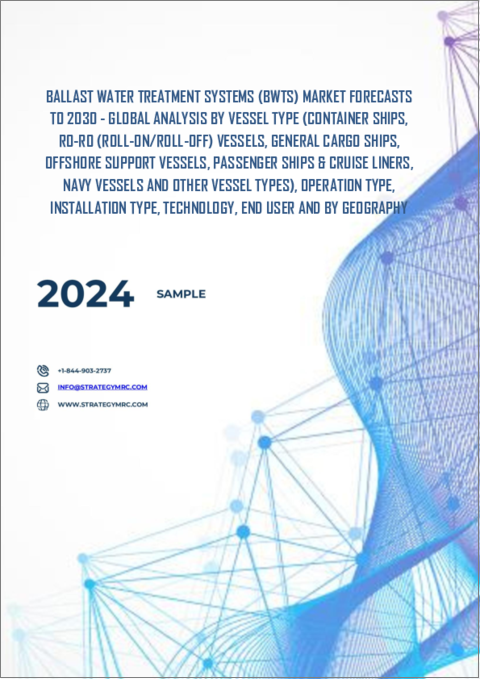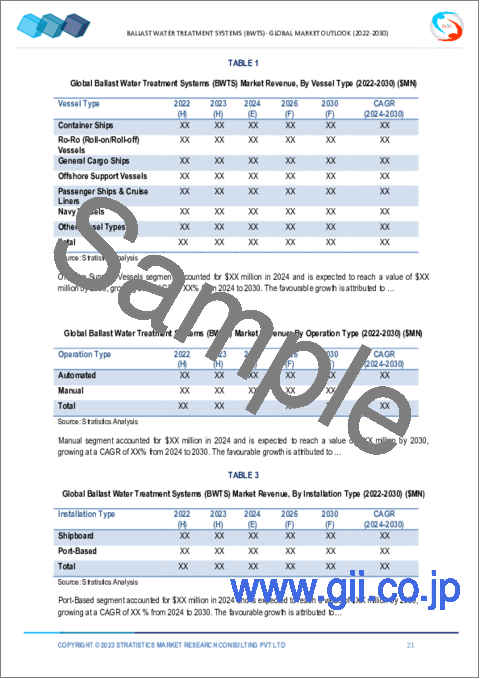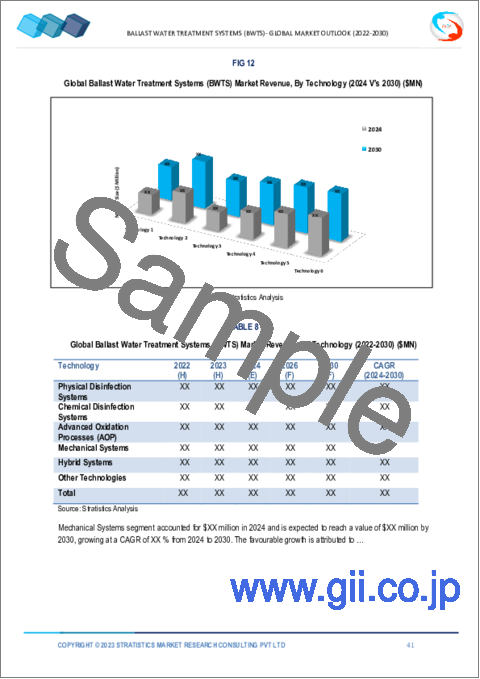|
|
市場調査レポート
商品コード
1503367
バラスト水処理システム(BWTS)市場の2030年までの予測: 船舶タイプ、操作タイプ、設置タイプ、技術、エンドユーザー、地域別の世界分析Ballast Water Treatment Systems Market Forecasts to 2030 - Global Analysis By Vessel Type, Operation Type, Installation Type, Technology, End User and By Geography |
||||||
カスタマイズ可能
|
|||||||
| バラスト水処理システム(BWTS)市場の2030年までの予測: 船舶タイプ、操作タイプ、設置タイプ、技術、エンドユーザー、地域別の世界分析 |
|
出版日: 2024年06月06日
発行: Stratistics Market Research Consulting
ページ情報: 英文 200+ Pages
納期: 2~3営業日
|
全表示
- 概要
- 図表
- 目次
Stratistics MRCによると、世界のバラスト水処理システム(BWTS)市場は、2024年に78億4,000万米ドルを占め、予測期間中にCAGR 10.8%で成長し、2030年には120億4,000万米ドルに達する見込みです。
バラスト水処理システム(BWTS)は、船舶が取り込むバラスト水中の外来種や病原体を除去または中和し、安定性とバランスを維持するために設計された技術です。これらのシステムは、有害な水生生物が地域を越えて移動するのを防ぎ、海洋生態系と生物多様性を保護します。これらのシステムは、国際的な規制、特に船舶が環境への影響を最小限に抑えるためにバラスト水を管理することを義務付けている国際海事機関のバラスト水管理条約に準拠しています。
UNCTADの報告書によると、2022年1月現在、船舶保有国上位5カ国は世界の船舶トン数の53%を占めています。ギリシャが55市場の18%を占め、中国(13%)、日本(11%)、シンガポール(6%)、香港特別行政区(5%)が続く。2021年には、世界の造船の94%が中国、韓国、日本で行われます。
国際海上貿易の増加
国際的な海上貿易の増加により、バラスト水を通じた外来種の拡散を防ぐための厳しい規制が必要となっています。世界の輸送量の増加に伴い、BWTSの需要は飛躍的に伸びています。これらのシステムは、バラスト水中の有害生物を中和・除去し、国際基準への適合を確実にする上で極めて重要です。BWTS市場の拡大は、規制遵守、環境問題、海洋生物多様性維持の必要性によって推進され、それによって世界中で高度な治療技術の革新と採用が加速しています。
レトロフィットの複雑さ
既存の船舶にBWTSを後付けするには、限られたスペース、構造変更、既存の船舶システムとの統合の課題など、いくつかの複雑な問題があります。これらの複雑さは、設置コストとダウンタイムを増加させ、船舶の運航を中断させる。さらに、古い船舶の改造には、最新の環境基準を満たすための大幅なアップグレードが必要となる場合があり、経済的負担が増します。その結果、多くの船主はBWTSの設置を遅らせたり、より効果的でないコンプライアンス方法を選んだりしており、市場の成長を妨げています。
海洋生態系保護への意識の高まりと取り組み
バラスト水を通じて輸送される外来種による海洋生態系の劣化に対する意識の高まりが、世界の取り組みや規制に拍車をかけています。政府や環境団体は、海洋生物多様性を保護するための厳格な対策を提唱しています。このような認識が、生態系への影響を緩和するためのBWTSの導入に拍車をかけています。また、海運会社は規制要件を満たすために準拠したソリューションを求めています。効果的な治療を確実にするために革新的な技術が開発されており、世界の意識の高まりと積極的な保護活動に応じて市場の成長を促しています。
高い設置費用とメンテナンス費用
BWTSの高い設置・保守コストは、多様な船舶構成に適合するようカスタマイズされた設計の必要性、既存の船舶システムとの複雑な統合、厳しい規制遵守要件に起因します。これらのコストは、特に経済の不確実性と競合圧力に直面する船主の足かせとなっています。その結果、より安価で効果の低いコンプライアンス方法を選択したり、設置を完全に遅らせたりするケースもあり、市場の成長が鈍化しています。
COVID-19の影響
COVID-19パンデミックは、造船所の閉鎖や旅行制限により、規制遵守期限の遅延や設置・改造プロセスの遅延を引き起こし、バラスト水処理システム(BWTS)市場を混乱させました。しかし、パンデミックは環境保護に対する意識を高め、BWTSに対する将来の需要を促進する可能性もあります。景気後退と海運活動の減少は一時的に市場の成長を鈍化させたが、回復努力と貿易再開によって市場は活性化すると予想されます。
予測期間中は自動化セグメントが最大になる見込み
自動化セグメントは有利な成長が見込まれます。自動バラスト水処理システムは、センサー、リアルタイムモニタリング、自動制御などの先進技術を使用することで、バラスト水管理を合理化します。これらのシステムは、効率を高め、規制遵守を確実にし、手動介入を最小限に抑えることで運用コストを削減します。自動化により精度と信頼性が向上し、より効果的に海洋生態系を外来種から保護することができます。
高度酸化プロセス(AOP)分野は予測期間中最も高いCAGRが見込まれる
高度酸化プロセス(AOP)分野は、予測期間中に最も高いCAGR成長が見込まれます。AOP技術は、強力な酸化反応を利用して、バラスト水中の有害な微生物や有機汚染物質を中和します。AOPシステムは通常、オゾン、紫外線、過酸化水素などの方法を組み合わせて、高効率の殺菌と厳しい規制基準への準拠を実現します。この技術は、さまざまな水質で効果的な治療を行い、化学物質の使用量を削減するなどの利点を提供します。
最大のシェアを占める地域
アジア太平洋地域は、海上貿易量が多く、海運活動が盛んであることから、予測期間中に最大の市場シェアを占めると予測されます。主な促進要因としては、地域政府と国際海事機関(IMO)による侵略的種の拡散を防ぐための厳しい規制が挙げられます。この地域の堅調な造船業と海洋環境保護に対する意識の高まりが、BWTSの採用をさらに後押ししています。しかし、技術の進歩と持続可能な海運慣行への関心の高まりは、アジア太平洋のBWTS市場に大きな成長機会をもたらしています。
CAGRが最も高い地域:
北米は、特に米国沿岸警備隊(USCG)基準やIMOバラスト水管理条約などの厳しい規制枠組みによって、予測期間中に最も高いCAGRを示すと予測されます。この地域は、環境保護と持続可能な海事慣行に重点を置いており、市場の成長をさらに促進しています。北米の広大な海岸線と大規模な港湾活動は、生態系の混乱を防ぐために効果的なバラスト水管理を必要とします。さらに、海洋環境イニシアティブに対する政府の支援は、北米のBWTS市場に大きな成長機会をもたらしています。
無料のカスタマイズサービス
本レポートをご購読のお客様には、以下の無料カスタマイズオプションのいずれかをご利用いただけます:
- 企業プロファイル
- 追加市場プレイヤーの包括的プロファイリング(3社まで)
- 主要企業のSWOT分析(3社まで)
- 地域セグメンテーション
- 顧客の関心に応じた主要国の市場推計・予測・CAGR(注:フィージビリティチェックによる)
- 競合ベンチマーキング
- 製品ポートフォリオ、地理的プレゼンス、戦略的提携に基づく主要企業のベンチマーキング
目次
第1章 エグゼクティブサマリー
第2章 序文
- 概要
- ステークホルダー
- 調査範囲
- 調査手法
- データマイニング
- データ分析
- データ検証
- 調査アプローチ
- 調査情報源
- 1次調査情報源
- 2次調査情報源
- 前提条件
第3章 市場動向分析
- 促進要因
- 抑制要因
- 機会
- 脅威
- 技術分析
- エンドユーザー分析
- 新興市場
- COVID-19の影響
第4章 ポーターのファイブフォース分析
- 供給企業の交渉力
- 買い手の交渉力
- 代替品の脅威
- 新規参入業者の脅威
- 競争企業間の敵対関係
第5章 世界のバラスト水処理システム(BWTS)市場:船舶タイプ別
- コンテナ船
- Ro-Ro(ロールオン/ロールオフ)船
- 一般貨物船
- オフショア支援船
- 客船とクルーズ船
- 海軍艦艇
- その他の船舶タイプ
第6章 世界のバラスト水処理システム(BWTS)市場:操作タイプ別
- 自動
- マニュアル
第7章 世界のバラスト水処理システム(BWTS)市場:設置タイプ別
- 船上
- 港ベース
第8章 世界のバラスト水処理システム(BWTS)市場:技術別
- 物理的消毒システム
- 紫外線(UV)
- 超音波治療
- 脱酸素化
- 化学消毒システム
- 塩素処理
- オゾン処理
- 高度酸化プロセス(AOP)
- 電気塩素処理
- ヒドロキシルラジカル
- 機械システム
- 濾過システム
- 遠心分離機
- ハイブリッドシステム
- その他の技術
第9章 世界のバラスト水処理システム(BWTS)市場:エンドユーザー別
- 港とターミナル
- 造船業
- 石油・ガス産業
- 養殖場
- その他のエンドユーザー
第10章 世界のバラスト水処理システム(BWTS)市場:地域別
- 北米
- 米国
- カナダ
- メキシコ
- 欧州
- ドイツ
- 英国
- イタリア
- フランス
- スペイン
- その他欧州
- アジア太平洋地域
- 日本
- 中国
- インド
- オーストラリア
- ニュージーランド
- 韓国
- その他アジア太平洋地域
- 南米
- アルゼンチン
- ブラジル
- チリ
- その他南米
- 中東・アフリカ
- サウジアラビア
- アラブ首長国連邦
- カタール
- 南アフリカ
- その他中東とアフリカ
第11章 主な発展
- 契約、パートナーシップ、コラボレーション、合弁事業
- 買収と合併
- 新製品発売
- 事業拡大
- その他の主要戦略
第12章 企業プロファイリング
- Alfa Laval
- Wartsila
- Mitsubishi Heavy Industries
- Panasia Corporation
- Mahle Group
- OceanSaver
- Qingdao Headway Technology
- Ecochlor
- Damen Shipyards Group
- Coldharbour Marine
- ERMA FIRST
- JFE Engineering Corporation
- BIO-UV Group
- Langh Tech AB
List of Tables
- Table 1 Global Ballast Water Treatment Systems (BWTS) Market Outlook, By Region (2022-2030) ($MN)
- Table 2 Global Ballast Water Treatment Systems (BWTS) Market Outlook, By Vessel Type (2022-2030) ($MN)
- Table 3 Global Ballast Water Treatment Systems (BWTS) Market Outlook, By Container Ships (2022-2030) ($MN)
- Table 4 Global Ballast Water Treatment Systems (BWTS) Market Outlook, By Ro-Ro (Roll-on/Roll-off) Vessels (2022-2030) ($MN)
- Table 5 Global Ballast Water Treatment Systems (BWTS) Market Outlook, By General Cargo Ships (2022-2030) ($MN)
- Table 6 Global Ballast Water Treatment Systems (BWTS) Market Outlook, By Offshore Support Vessels (2022-2030) ($MN)
- Table 7 Global Ballast Water Treatment Systems (BWTS) Market Outlook, By Passenger Ships & Cruise Liners (2022-2030) ($MN)
- Table 8 Global Ballast Water Treatment Systems (BWTS) Market Outlook, By Navy Vessels (2022-2030) ($MN)
- Table 9 Global Ballast Water Treatment Systems (BWTS) Market Outlook, By Other Vessel Types (2022-2030) ($MN)
- Table 10 Global Ballast Water Treatment Systems (BWTS) Market Outlook, By Operation Type (2022-2030) ($MN)
- Table 11 Global Ballast Water Treatment Systems (BWTS) Market Outlook, By Automated (2022-2030) ($MN)
- Table 12 Global Ballast Water Treatment Systems (BWTS) Market Outlook, By Manual (2022-2030) ($MN)
- Table 13 Global Ballast Water Treatment Systems (BWTS) Market Outlook, By Installation Type (2022-2030) ($MN)
- Table 14 Global Ballast Water Treatment Systems (BWTS) Market Outlook, By Shipboard (2022-2030) ($MN)
- Table 15 Global Ballast Water Treatment Systems (BWTS) Market Outlook, By Port-Based (2022-2030) ($MN)
- Table 16 Global Ballast Water Treatment Systems (BWTS) Market Outlook, By Technology (2022-2030) ($MN)
- Table 17 Global Ballast Water Treatment Systems (BWTS) Market Outlook, By Physical Disinfection Systems (2022-2030) ($MN)
- Table 18 Global Ballast Water Treatment Systems (BWTS) Market Outlook, By Ultraviolet (UV) Radiation (2022-2030) ($MN)
- Table 19 Global Ballast Water Treatment Systems (BWTS) Market Outlook, By Ultrasonic Treatment (2022-2030) ($MN)
- Table 20 Global Ballast Water Treatment Systems (BWTS) Market Outlook, By Deoxygenation (2022-2030) ($MN)
- Table 21 Global Ballast Water Treatment Systems (BWTS) Market Outlook, By Chemical Disinfection Systems (2022-2030) ($MN)
- Table 22 Global Ballast Water Treatment Systems (BWTS) Market Outlook, By Chlorination (2022-2030) ($MN)
- Table 23 Global Ballast Water Treatment Systems (BWTS) Market Outlook, By Ozonation (2022-2030) ($MN)
- Table 24 Global Ballast Water Treatment Systems (BWTS) Market Outlook, By Advanced Oxidation Processes (AOP) (2022-2030) ($MN)
- Table 25 Global Ballast Water Treatment Systems (BWTS) Market Outlook, By Electrochlorination (2022-2030) ($MN)
- Table 26 Global Ballast Water Treatment Systems (BWTS) Market Outlook, By Hydroxyl Radicals (2022-2030) ($MN)
- Table 27 Global Ballast Water Treatment Systems (BWTS) Market Outlook, By Mechanical Systems (2022-2030) ($MN)
- Table 28 Global Ballast Water Treatment Systems (BWTS) Market Outlook, By Filtration Systems (2022-2030) ($MN)
- Table 29 Global Ballast Water Treatment Systems (BWTS) Market Outlook, By Centrifugal Separators (2022-2030) ($MN)
- Table 30 Global Ballast Water Treatment Systems (BWTS) Market Outlook, By Hybrid Systems (2022-2030) ($MN)
- Table 31 Global Ballast Water Treatment Systems (BWTS) Market Outlook, By Other Technologies (2022-2030) ($MN)
- Table 32 Global Ballast Water Treatment Systems (BWTS) Market Outlook, By End User (2022-2030) ($MN)
- Table 33 Global Ballast Water Treatment Systems (BWTS) Market Outlook, By Ports & Terminals (2022-2030) ($MN)
- Table 34 Global Ballast Water Treatment Systems (BWTS) Market Outlook, By Shipbuilding Industry (2022-2030) ($MN)
- Table 35 Global Ballast Water Treatment Systems (BWTS) Market Outlook, By Oil & Gas Industry (2022-2030) ($MN)
- Table 36 Global Ballast Water Treatment Systems (BWTS) Market Outlook, By Aquaculture Farms (2022-2030) ($MN)
- Table 37 Global Ballast Water Treatment Systems (BWTS) Market Outlook, By Other End Users (2022-2030) ($MN)
Note: Tables for North America, Europe, APAC, South America, and Middle East & Africa Regions are also represented in the same manner as above.
According to Stratistics MRC, the Global Ballast Water Treatment Systems (BWTS) Market is accounted for $7.84 billion in 2024 and is expected to reach $12.04 billion by 2030 growing at a CAGR of 10.8% during the forecast period. Ballast Water Treatment Systems (BWTS) are technologies designed to eliminate or neutralize invasive species and pathogens in ballast water taken on by ships to maintain stability and balance. These systems prevent the transfer of harmful aquatic organisms across regions, protecting marine ecosystems and biodiversity. They comply with international regulations, particularly the International Maritime Organization's Ballast Water Management Convention, which mandates that ships manage ballast water to minimize environmental impact.
According to the UNCTAD report, as of January 2022, the top five ship-owning economies accounted for 53% of global fleet tonnage. Greece accounted for 18% of the 55market, followed by China (13%), Japan (11%), Singapore (6%), and Hong Kong SAR (5%). 94% of global shipbuilding occurred in China, the Republic of Korea, and Japan in 2021.
Market Dynamics:
Driver:
Increasing international maritime trade
Increasing international maritime trade necessitates stringent regulations to prevent the spread of invasive species through ballast water. As global shipping volumes rise, the demand for BWTS grows exponentially. These systems are crucial in neutralizing and eliminating harmful organisms in ballast water, ensuring compliance with international standards. The expanding BWTS market is driven by regulatory compliance, environmental concerns, and the need to maintain marine biodiversity, thereby accelerating innovation and adoption of advanced treatment technologies worldwide.
Restraint:
Retrofit complexities
Retrofitting BWTS onto existing vessels poses several complexities, including limited space availability, structural modifications, and integration challenges with existing ship systems. These complexities increase installation costs and downtime, disrupting vessel operations. Furthermore, retrofitting older ships may require significant upgrades to meet modern environmental standards, adding to the financial burden. Consequently, many ship owners delay BWTS installations or opt for less effective compliance methods, hindering market growth.
Opportunity:
Growing awareness and initiatives to protect marine ecosystems
Growing awareness of marine ecosystem degradation due to invasive species transported via ballast water has spurred global initiatives and regulations. Governments and environmental organizations are advocating for stringent measures to protect marine biodiversity. This awareness has catalyzed the adoption of BWTS to mitigate ecological impacts. Also, shipping companies seek compliant solutions to meet regulatory requirements. Innovative technologies are being developed to ensure effective treatment, driving market growth in response to heightened awareness and proactive conservation efforts globally.
Threat:
High installation and maintenance costs
High installation and maintenance costs in BWTS stem from the need for customized designs to fit diverse ship configurations, complex integration with existing vessel systems, and stringent regulatory compliance requirements. These costs deter ship owners, particularly in the face of economic uncertainties and competitive pressures. Consequently, some opt for cheaper, less effective compliance methods or delay installations altogether, slowing market growth.
Covid-19 Impact
The covid-19 pandemic disrupted the ballast water treatment systems (BWTS) market by causing delays in regulatory compliance deadlines and slowing down installation and retrofitting processes due to shipyard closures and travel restrictions. However, the pandemic also heightened awareness of environmental protection, potentially driving future demand for BWTS. The economic downturn and reduced shipping activities temporarily dampened market growth, but recovery efforts and resuming trade are expected to revitalize the market.
The automated segment is expected to be the largest during the forecast period
The automated segment is estimated to have a lucrative growth. Automated ballast water treatment systems streamline ballast water management by using advanced technologies such as sensors, real-time monitoring, and automated controls. These systems enhance efficiency, ensure regulatory compliance, and reduce operational costs by minimizing manual intervention. Automation improves accuracy and reliability, helping to protect marine ecosystems from invasive species more effectively.
The advanced oxidation processes (AOP) segment is expected to have the highest CAGR during the forecast period
The advanced oxidation processes (AOP) segment is anticipated to witness the highest CAGR growth during the forecast period. AOP technology in utilizes powerful oxidation reactions to neutralize harmful microorganisms and organic pollutants in ballast water. AOP systems typically combine methods like ozone, UV radiation, and hydrogen peroxide to achieve high-efficiency disinfection and compliance with stringent regulatory standards. This technology offers advantages such as effective treatment across varying water qualities and reduced chemical usage.
Region with largest share:
Asia Pacific is projected to hold the largest market share during the forecast period due to its large volume of maritime trade and extensive shipping activities. Key drivers include stringent regulations by regional governments and the International Maritime Organization (IMO) to prevent the spread of invasive species. The region's robust shipbuilding industry and increasing awareness of marine environmental protection further boost BWTS adoption. However, technological advancements and the growing focus on sustainable shipping practices present substantial growth opportunities for the BWTS market in the Asia Pacific.
Region with highest CAGR:
North America is projected to have the highest CAGR over the forecast period, driven by strict regulatory frameworks, particularly the U.S. Coast Guard (USCG) standards and the IMO Ballast Water Management Convention. The region's focus on environmental protection and sustainable maritime practices further fuels market growth. North America's extensive coastline and significant port activities necessitate effective ballast water management to prevent ecological disruptions. Further, government support for maritime environmental initiatives present strong growth opportunities for the BWTS market in North America.
Key players in the market
Some of the key players profiled in the Ballast Water Treatment Systems (BWTS) Market include Alfa Laval, Wartsila, Mitsubishi Heavy Industries, Panasia Corporation, Mahle Group, OceanSaver, Qingdao Headway Technology, Ecochlor, Damen Shipyards Group, Coldharbour Marine, ERMA FIRST, JFE Engineering Corporation, BIO-UV Group and Langh Tech AB.
Key Developments:
In October 2023, BIO-UV Group has launched the new BIO-SEA L01-0030 Mini-more compact than the company's existing low-flow BIO-SEA L range-is a fully automated filtration + UV-based system designed to treat ballast water flow rates between 13m3/h and 30m3/h from a unit that has a skid footprint of just 1m2.
In June 2023, Langh Tech has launched its new ballast water management system. The in-house product development project was completed on a very fast schedule - in less than a year from first ideas to product launch. In addition to the compact size in its UV-C irradiation-based treatment unit, Langh Tech has paid special attention to the ease of operation and maintenance of the unit.
Vessel Types Covered:
- Container Ships
- Ro-Ro (Roll-on/Roll-off) Vessels
- General Cargo Ships
- Offshore Support Vessels
- Passenger Ships & Cruise Liners
- Navy Vessels
- Other Vessel Types
Operation Types Covered:
- Automated
- Manual
Installation Types Covered:
- Shipboard
- Port-Based
Technologies Covered:
- Physical Disinfection Systems
- Chemical Disinfection Systems
- Advanced Oxidation Processes (AOP)
- Mechanical Systems
- Hybrid Systems
- Other Technologies
End Users Covered:
- Ports & Terminals
- Shipbuilding Industry
- Oil & Gas Industry
- Aquaculture Farms
- Other End Users
Regions Covered:
- North America
- US
- Canada
- Mexico
- Europe
- Germany
- UK
- Italy
- France
- Spain
- Rest of Europe
- Asia Pacific
- Japan
- China
- India
- Australia
- New Zealand
- South Korea
- Rest of Asia Pacific
- South America
- Argentina
- Brazil
- Chile
- Rest of South America
- Middle East & Africa
- Saudi Arabia
- UAE
- Qatar
- South Africa
- Rest of Middle East & Africa
What our report offers:
- Market share assessments for the regional and country-level segments
- Strategic recommendations for the new entrants
- Covers Market data for the years 2022, 2023, 2024, 2026, and 2030
- Market Trends (Drivers, Constraints, Opportunities, Threats, Challenges, Investment Opportunities, and recommendations)
- Strategic recommendations in key business segments based on the market estimations
- Competitive landscaping mapping the key common trends
- Company profiling with detailed strategies, financials, and recent developments
- Supply chain trends mapping the latest technological advancements
Free Customization Offerings:
All the customers of this report will be entitled to receive one of the following free customization options:
- Company Profiling
- Comprehensive profiling of additional market players (up to 3)
- SWOT Analysis of key players (up to 3)
- Regional Segmentation
- Market estimations, Forecasts and CAGR of any prominent country as per the client's interest (Note: Depends on feasibility check)
- Competitive Benchmarking
- Benchmarking of key players based on product portfolio, geographical presence, and strategic alliances
Table of Contents
1 Executive Summary
2 Preface
- 2.1 Abstract
- 2.2 Stake Holders
- 2.3 Research Scope
- 2.4 Research Methodology
- 2.4.1 Data Mining
- 2.4.2 Data Analysis
- 2.4.3 Data Validation
- 2.4.4 Research Approach
- 2.5 Research Sources
- 2.5.1 Primary Research Sources
- 2.5.2 Secondary Research Sources
- 2.5.3 Assumptions
3 Market Trend Analysis
- 3.1 Introduction
- 3.2 Drivers
- 3.3 Restraints
- 3.4 Opportunities
- 3.5 Threats
- 3.6 Technology Analysis
- 3.7 End User Analysis
- 3.8 Emerging Markets
- 3.9 Impact of Covid-19
4 Porters Five Force Analysis
- 4.1 Bargaining power of suppliers
- 4.2 Bargaining power of buyers
- 4.3 Threat of substitutes
- 4.4 Threat of new entrants
- 4.5 Competitive rivalry
5 Global Ballast Water Treatment Systems (BWTS) Market, By Vessel Type
- 5.1 Introduction
- 5.2 Container Ships
- 5.3 Ro-Ro (Roll-on/Roll-off) Vessels
- 5.4 General Cargo Ships
- 5.5 Offshore Support Vessels
- 5.6 Passenger Ships & Cruise Liners
- 5.7 Navy Vessels
- 5.8 Other Vessel Types
6 Global Ballast Water Treatment Systems (BWTS) Market, By Operation Type
- 6.1 Introduction
- 6.2 Automated
- 6.3 Manual
7 Global Ballast Water Treatment Systems (BWTS) Market, By Installation Type
- 7.1 Introduction
- 7.2 Shipboard
- 7.3 Port-Based
8 Global Ballast Water Treatment Systems (BWTS) Market, By Technology
- 8.1 Introduction
- 8.2 Physical Disinfection Systems
- 8.2.1 Ultraviolet (UV) Radiation
- 8.2.2 Ultrasonic Treatment
- 8.2.3 Deoxygenation
- 8.3 Chemical Disinfection Systems
- 8.3.1 Chlorination
- 8.3.2 Ozonation
- 8.4 Advanced Oxidation Processes (AOP)
- 8.4.1 Electrochlorination
- 8.4.2 Hydroxyl Radicals
- 8.5 Mechanical Systems
- 8.5.1 Filtration Systems
- 8.5.2 Centrifugal Separators
- 8.6 Hybrid Systems
- 8.7 Other Technologies
9 Global Ballast Water Treatment Systems (BWTS) Market, By End User
- 9.1 Introduction
- 9.2 Ports & Terminals
- 9.3 Shipbuilding Industry
- 9.4 Oil & Gas Industry
- 9.5 Aquaculture Farms
- 9.6 Other End Users
10 Global Ballast Water Treatment Systems (BWTS) Market, By Geography
- 10.1 Introduction
- 10.2 North America
- 10.2.1 US
- 10.2.2 Canada
- 10.2.3 Mexico
- 10.3 Europe
- 10.3.1 Germany
- 10.3.2 UK
- 10.3.3 Italy
- 10.3.4 France
- 10.3.5 Spain
- 10.3.6 Rest of Europe
- 10.4 Asia Pacific
- 10.4.1 Japan
- 10.4.2 China
- 10.4.3 India
- 10.4.4 Australia
- 10.4.5 New Zealand
- 10.4.6 South Korea
- 10.4.7 Rest of Asia Pacific
- 10.5 South America
- 10.5.1 Argentina
- 10.5.2 Brazil
- 10.5.3 Chile
- 10.5.4 Rest of South America
- 10.6 Middle East & Africa
- 10.6.1 Saudi Arabia
- 10.6.2 UAE
- 10.6.3 Qatar
- 10.6.4 South Africa
- 10.6.5 Rest of Middle East & Africa
11 Key Developments
- 11.1 Agreements, Partnerships, Collaborations and Joint Ventures
- 11.2 Acquisitions & Mergers
- 11.3 New Product Launch
- 11.4 Expansions
- 11.5 Other Key Strategies
12 Company Profiling
- 12.1 Alfa Laval
- 12.2 Wartsila
- 12.3 Mitsubishi Heavy Industries
- 12.4 Panasia Corporation
- 12.5 Mahle Group
- 12.6 OceanSaver
- 12.7 Qingdao Headway Technology
- 12.8 Ecochlor
- 12.9 Damen Shipyards Group
- 12.10 Coldharbour Marine
- 12.11 ERMA FIRST
- 12.12 JFE Engineering Corporation
- 12.13 BIO-UV Group
- 12.14 Langh Tech AB






